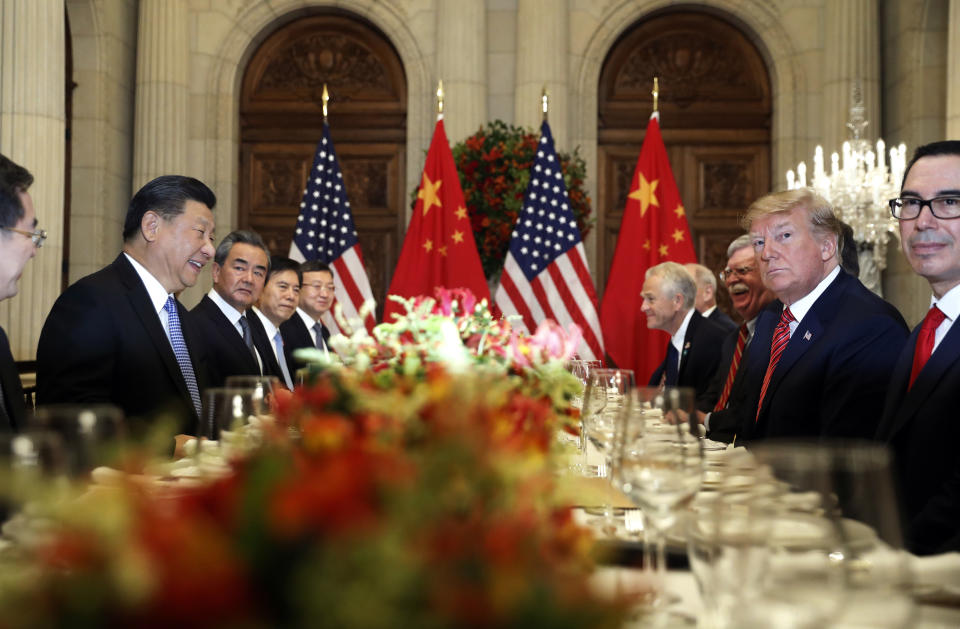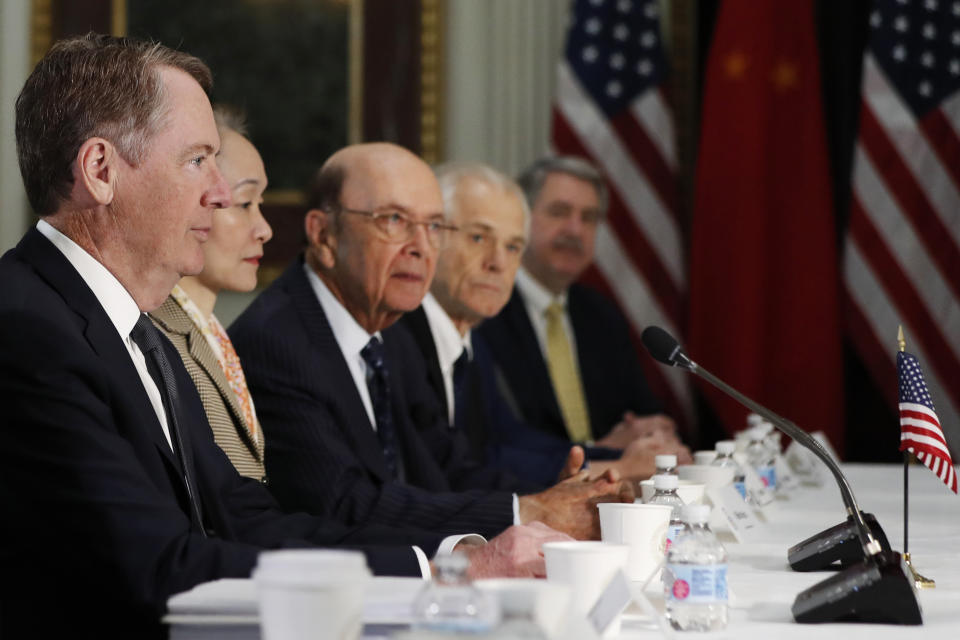Expert: 'We are worse off as a world' amid Trump's trade war
The effects of the ongoing U.S.-China trade war on American farmers has been well-documented, and one expert asserts that the scope goes beyond that.
Wes Peterson, a professor of agricultural economics at the University of Nebraska-Lincoln, emphasized the global impact of the trade war.
“Trump says that trade wars are easy to win,” Peterson told Yahoo Finance. “What does it mean to ‘win’ a trade war? Basically, you’ve done damage to part of your economy.”
He continued: “If you start with a world where trade is flowing normally and you start putting tariffs on, you’ve introduced a bunch of inefficiencies and distortions into global markets that will reduce the level of world output. We are worse off as a world.”

‘Consumers will end up paying a higher price ...’
In 2018, the U.S. trade deficit in goods reached a record $891.3 billion. A New York Times report noted that trade war with China “widened the gap: Stiff tariffs on Chinese goods helped slow China’s economy, crimping American exports, which declined nearly 50% in December from the same month a year before.”
Peterson explained that there are two main effects of the tariffs on China. The first is that it raises the prices for consumers.
“When we raise a tariff in general on steel, it means all the industries that use steel to make things, like cars and refrigerators, will see their cost go up, and they will pass those costs on to consumers,” he said. “So, consumers will end up paying a higher price for cars and refrigerators.”
The second is that is “depresses the price” for foreigners selling into the U.S.
“The [foreign] producers, who are trying to sell in the U.S., see some decline in the prices that they’re receiving.” he said. “They don’t like that, and their governments don’t like it, so the governments almost always will retaliate. That’s what happened with China.”

‘Both the consumer and producer bear the cost’
The trade tensions between the U.S. and China began in March 2018, when the U.S. imposed a 25% tariff on all steel imports and a 10% tariff on aluminum imports.
China retaliated by slapping tariffs on products ranging from pork to fruit and aluminum. One day later, the U.S. announced 25% tariffs on roughly 1,300 Chinese products, worth $50 billion. China, in turn, imposed 25% tariffs on more products, including soybeans.
“The prices of soybeans in China go up because of the tax, the prices for soybean farmers in the U.S. go down because there’s less demand for soybeans, so their price falls,” Peterson said. “So both the consumer and producer bear the cost of this Chinese tariff.”
Soybean farmers were among those hit the hardest by the tariffs, as U.S. soybean exports to China were down 98% in 2018. The Trump administration has doled out financial aid to farmers totaling $7.7 billion.
The back-and-forth would continue, until the two countries agreed to a temporary truce in December 2018 at the G20 Summit in Argentina. A March 1 deadline was set for a deal, the deadline passed, and now a summit between President Trump and Chinese President Xi Jinping is delayed until at least April.

‘It gets terrifically complicated’
“What I think is one of the big problems with the whole discussion of trade is it almost always focuses on just producers,” Peterson said. “When in fact, the impact of tariffs or trade barriers affect both producers and consumers.”
Putting a specific number of how the tariffs have affected consumers financially is a bit trickier though, he admitted.
“Our tariffs in China are going to hurt consumers in the U.S., they’ll hurt producers in China, so China retaliates, that hurts consumers in China, and helps producers in China, and it gets to be a huge mess!” Peterson said. “You’ve got all these contradictory forces. What is the net effect going to be of all of that? Well, it depends then on precisely what industries get hit, the size of the tariffs, and how long they’re there. It gets terrifically complicated.”
One study found that “Trump tariffs cost American consumers and producers $68.8 billion per year in higher costs and lost output, with the tariffs paid entirely by Americans.” A different study concluded that the tariffs have generated nearly $3 billion per month in new taxes.

“At some point in the future, people will be in a situation and they’re not going to say, ‘Woe is me, it’s because of the trade war,’” Peterson said. “Their incomes may have gone up, they may not have gone up as much as they would have gone up if you hadn’t had the trade war, but you can’t know that. It’s a very difficult think to make a case that the trade war’s going to be very costly, although I think it will be.
He continued: “What about the British in 2025, after Brexit? Will they be able to say, ‘If we hadn’t done that stupid Brexit thing, I would have $25 more a week in my paycheck than I do?’ They won’t be able to say that, because they can’t possibly know what would have happened exactly if they hadn’t done Brexit.”
Peterson referenced the Smoot-Hawley Tariff Act of 1930, which increased import duties by 50%. It was intended to protect American farmers, who were dealing with increased competition, overproduction, and declining prices.
“We raised [tariffs] after the stock market crash, and world trade contracted by about two-thirds,” he said. “It turned out, in the U.S., our imports went down by 60%, but our exports also went down by 60%. We just lost on both counts.”
‘There could be permanent damage from the trade war’
With the Chinese showing good faith by buying U.S. soybeans, Peterson does think there is a chance for there to be a full recovery for both consumers and producers in this trade war. At the same, though, the damage may have already been done.
“Those kinds of things take longer to sort themselves out,” Peterson said. “There could be permanent damage from the trade war, just because it interrupts all of these relationships that people build up over time in conducting their business.”

Soybeans are a stark example. Chinese importers, who began purchasing soybeans from Brazil at the height of the trade war, could permanently choose to take their business elsewhere.
“Trade wars generally are going to leave everybody worse off,” Peterson said. “They’re not the kinds of things that can be ‘won.’ To talk about winning and losing trade wars is, I think, to miss the boat. What we want is to try to have open markets, free trade, as much as possible.”
Adriana is an associate editor for Yahoo Finance. Follow her on Twitter @adrianambells.
READ MORE:
Analyst: There's a 35% chance U.S.-China trade talks break down
Trump’s farmer bailout just hit $7.7 billion – but 'it no way makes us whole'
Follow Yahoo Finance on Twitter, Facebook, Instagram, Flipboard, LinkedIn, YouTube, and reddit.

 Yahoo Finance
Yahoo Finance 